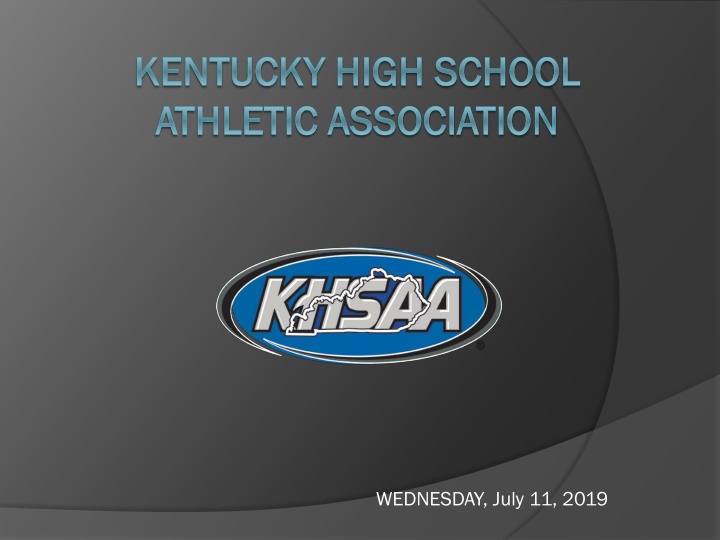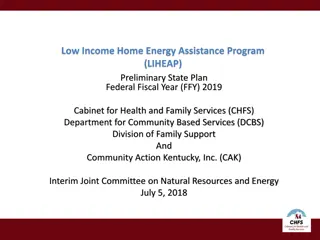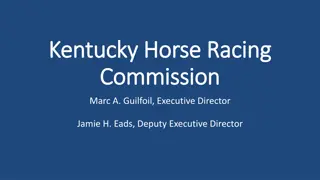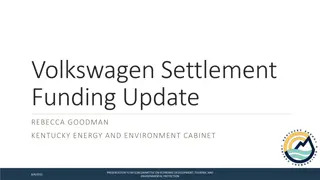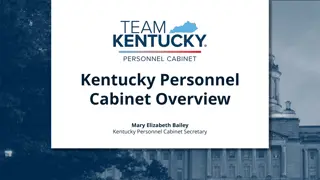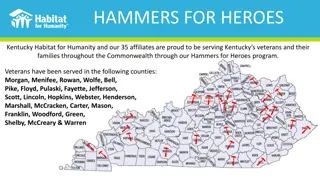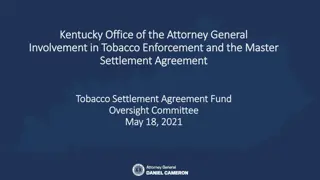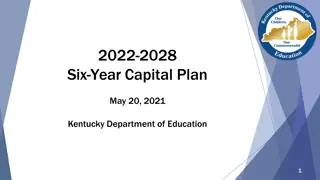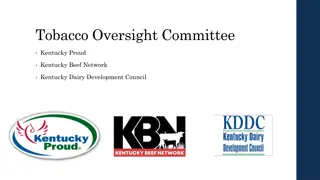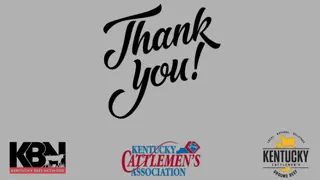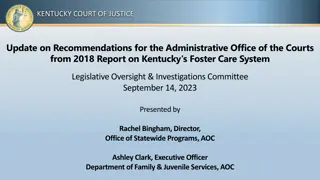Evolution of Kentucky High School Athletic Association Governance
Founded over 100 years ago, the Kentucky High School Athletic Association has undergone transitions in governance structures in the 1970s and 1980s. From federal court orders to changes in commissioner leadership, the organization has adapted to manage athletics in Kentucky schools effectively. Today, it boasts a significant number of participants and schools while maintaining its independent status. The Authority for its oversight lies with the Kentucky Board of Education, as mandated by KRS 156.070.
Download Presentation

Please find below an Image/Link to download the presentation.
The content on the website is provided AS IS for your information and personal use only. It may not be sold, licensed, or shared on other websites without obtaining consent from the author.If you encounter any issues during the download, it is possible that the publisher has removed the file from their server.
You are allowed to download the files provided on this website for personal or commercial use, subject to the condition that they are used lawfully. All files are the property of their respective owners.
The content on the website is provided AS IS for your information and personal use only. It may not be sold, licensed, or shared on other websites without obtaining consent from the author.
E N D
Presentation Transcript
KENTUCKY HIGH SCHOOL KENTUCKY HIGH SCHOOL ATHLETIC ASSOCIATION ATHLETIC ASSOCIATION WEDNESDAY, July 11, 2019
Origins Founded as a non-profit more than 100 years ago. Classified by IRS as 501(c)3 since the 1950s Independently audited by CPA firm specializing in non-profits each year, including Management Correspondence and appropriate IRS 990 KHSAA Constitution spells out formation, composition and duties of Board of Control, and dissolution parameters Member of NFHS for collaboration but independent from mandates
Today 57,639 boys and 48,575 girls on rosters in 17-18 54 championships 13 sports and 6 sport-activities 12,000 coaches 4,000 officials 281 schools Best drop-out prevention program
Transition in 1970s Federal Court Order Entered in 1971, E. Deedom Alston v. Kentucky High School Athletic Association, United States District Court, Eastern District of Kentucky, Lexington Division Order specifies Board of Control composition as well as requirements related to officiating Federal Court Order stands today.
Transition in 1970s Retirement of Ted Sanford as long-time first Commissioner in 1972, followed by long-time assistant Joe Billy Mansfield in 1975 Mansfield replaced by Frankfort Superintendent L. Tom Mills, who served from 1975 to 1991
Continued Transition KRS 156.070 amended to allow formal KBE designation of outside entity to manage athletics 702 KAR 7:065 revised to reflect statutory change Positions in KHSAA office requiring college degree placed under KTRS (KRS 161.220 (4) (f), late 1970s
Continued Transition in 1980s Positions in KHSAA not requiring or holding college degree placed under KERS by Executive Order of Gov. Martha Layne Collins, October, 1984 KHSAA is considered quasi in current discussions
Authority KRS 156.070 (2) requires the Kentucky Board of Education (KBE) to manage and control the common schools, including interscholastic athletics in the schools, and authorizes the KBE to designate an agency to manage athletics. The KHSAA is the designated agency of the Kentucky Board of Education as per Kentucky Administrative Regulation 702 KAR 7:065. This administrative regulation annually designates an agent for high school athletics; establishes the financial planning and review processes for the agent; and incorporates by reference the bylaws, procedures and rules of the agent.
KHSAA Organizational Structure Kentucky Board of Education through 702 KAR 7:065, as well as other National rules which may be in place Kentucky General Assembly through KRS 156.070 (2) KHSAA Board of Control elected by schools, appointed by KDE Commissioner hired by Board of Control who hires staff Member Schools agreeing to abide by rules and regulations
Recent Collaborative Changes Until mid 1990s, KHSAA Board determined student eligibility after initial review by Commissioner Composition of Board led to allegations and innuendo regarding decisions as well as inconsistent rulings In 1996, KHSAA appeals made are to be conducted under KRS 13B, using Independent Hearing Officer due to legislative action (administrative hearings)
Recent Collaborative Changes Worked collaboratively with authors of legislation on transition from slow pitch to fast pitch softball, and on expanding pool of coaches by allowing non-teaching coaches in all sports 2009, staff partnered with legislature to help author HB383 (KRS160.445), requiring safety training for coaches and facility specific emergency action plans
Recent Collaborative Changes Revised Due Process to Streamline and expedite, 2009- 2010 Old Procedure had Commissioner on initial ruling, then Board on final ruling after independent administrative hearing. Lengthy delays, etc. Revised Procedure has staff serve as initial ruling officer, Final ruling via Commissioner following independent administrative hearing. Less time, but appeal windows must be honored Ruling Officer s Ruling Within 30 days, normally 7-10 Notice of Appeal for Hearing Administrative Hearing with Independent Hearing Officer 20 days notice Recommended Order by Hearing Officer Within 30 days of receipt of official record, normally less than 14 1000 rulings per year, around 120 appeals
Recent Collaborative Changes In accordance with 702 KAR 7:065 and KBE directive, established Title IX compliance program in 1999 Retired educators trained to go to schools and evaluate everything related to Title IX and athletics Have completed three cycles of visits to all schools, approximately $70 to $90 thousand per year without cost to schools or appropriation
Recent Collaborative Changes In 2010s, worked collaboratively with General Assembly and KBE on implementing middle school requirements due to concerns about health and safety upon task force completion In late 2010s, worked collaboratively with General Assembly and KBE on implementing opportunities for home schooled students to compete against KHSAA schools for first time
Daily Operations No General Fund appropriation School Dues Annual, all inclusive (no per sport charge like many states) Event revenue (primary support, basketball and football) is all from state round, unlike any other state associations Corporate Support and Sponsorship
Daily Operations Own Office Building, Debt Free Approximately $4M flows through each year Annual audit and must comply with GASB standards for non-profits Retirement System Currently Having Huge Impact, particularly KERS Nearly all of the school dues collected is remitted to pay for the catastrophic insurance for all participants and liability insurance for all rounds of play
Operational Philosophy It is not the objective in any of the 19 KHSAA championships, to create an event that ensures the absolute best possible field is at the state tournament or that quality of play is a criterion The role of the Board of Control in developing policy, and of the staff in implementing that policy through procedures and events, is to ensure that all regions of the state have an opportunity to have competitors experience the state championship and represent their schools, communities and regions This may not always result in the absolute best individuals or teams, or even the best quality of play, but does ensure a quality experience for all.
Staffing 13 Full-time Staff- 9 covered by KTRS, 4 by KERS 4 Full-time Staff covered by KERS, 2 will have job transfers and no longer be eligible for KERS as of August 1, one has retirement pending, and 1 is in transitional phase of likely transfer to different position 3 part-time staff, including custodian 4 retired school administrators helping with Title IX audit program
Basic Organization Organization of Member Schools No school more important than any other school All have equal influence, from our smallest, Holy Family and its 20 students in Ashland, to Lafayette and its 2,486 which is largest with split of Scott County Bylaw 1, first Bylaw, designates that the Principal is the primary person responsible for school, and can designate an individual to act in that role (normally Athletic Director) Bylaw 1 foundational to operations
Governance of KHSAA Constitution Establishes a Board of Control Eighteen Board members 8 elected by schools, 2 per basketball region 2 elected by schools, designated to represent regions 1-8 and 9-16 (female) 2 elected by schools, designated to represent regions 1-8 and 9-16 (African American) 2 elected by schools, designated to represent regions 1-8 and 9-16 (non-public schools) 4 appointed by Kentucky Department of Education
Current Board makeup Two retirees serving as KBE appointees, a farmer and a retired coach Car Dealer and farmer 1 School Principal 1 Assistant Principal 2 District Athletic Directors and Former Coaches School Athletic Director School AD and Coach Guidance Counselor College Professor Diocese Education Director 5 Superintendents Assistant Superintendent and Cheer Coach
Process for Promulgating Administrative Regulations Process Necessary to give Constitution, Bylaws, Due Process and Board of Control Policies force of law through state regulation Schools Submit Proposals by May 1 from membership or Board Review by Board of Control for decision on inclusion in agenda (from KBE Task Force) Annual Meeting mid-September Final Review and Recommendation by BOC to KBE (2 KBE meetings and LSAC and other group review) KBE Final Review and Recommendation to LRC Adoption Consideration through LRC (ARRS) Hopeful final approval by late spring/summer of following year
Bylaws 2 through 14, Eligibility Bylaw 2-Age Restriction Bylaw 3-Number of Semesters Bylaw 4-Enrollment Requirement Bylaw 5-Academic Requirement Bylaw 6-Domestic Transfer Rule Bylaw 7-Students Under Education VISA Bylaw 8-Contestant on Other Teams
Bylaws 2 through 14, Eligibility Bylaw 9-Outside Team Restriction (BK, FB only) Bylaw 10-Amateur Status and Awards Bylaw 11-Financial Aid Bylaw 12-Requirement for Physical and Insurance Bylaw 13-Professional Contracts Bylaw 14-Other Eligibility Including practice/play while ineligible
Other Bylaws that cause problems for Principals Bylaw 22-Contests Bylaw 23-Limitation of Seasons Bylaw 24-Dead Period Bylaw 25-Coaching Requirements Bylaw 27-Penalties
Regulations vs. Rules Annually, the Constitution, Bylaws, Due Process Procedure, Board Policies and Necessary Forms are reviewed through the regulatory process, with the Board of Control having final authority over the conduct of tournaments through competition rules Competition rules have always been necessarily fluid as schools add and delete sports, playing rules change, and safeguards are necessary to help ensure competitive equity and curb cheating
Ongoing Efforts-Typical Business Ever-evolving Opportunities Field Hockey opportunity for females continues to be evaluated Addition of six sport-activities since 2010, Archery, Bass Fishing, Bowling, Cheer, Dance and Esports Must not neglect long-standing sports just because of new ones
Ongoing Efforts-Typical Business Football Alignment Every four years based on four-year average enrollment Adjustments on School Size every two years Classify based on enrollment only
Ongoing Efforts-Typical Business Baseball / Softball Changes Tournaments needed to be similar Prior girls event not at same standard in terms of facility, almost exclusively due to format Formats for both revised to ensure top participation experience Historic partnership with regional universities Already have changes for 2020 based on evaluation, always reviewing
Ongoing Efforts-Typical Business Golf Format Changes Unfortunately, were trying to be all things to all people, conducting both a team tournament and individual tournament simultaneously, and bringing multiple teams from each region Virtually no other state plays a practice round and 2 competition rounds per gender, a six-day commitment for those coaching both genders Confirmed as late as June of 2019, the total attempted field of 156 was appreciably higher than other states and contributes to past, unaddressed issue The Board began in summer of 2018 reviewing the issue and gathering entry data from schools Too many tee times in late fall forced extra expenditure of funds due to delays Member schools had expressed continual feedback to equalize the number of regions in boys and girls golf and be in same for both Communication was made with school Principals and Athletic Directors on four occasions, continually keeping them updated and soliciting feedback
Ongoing Efforts-Typical Business Golf Format Changes 68 girls and 37 boys schools who entered regional players did not have enough for a team Between 25% and 30% of the girls teams only had four participants, between 15% and 20% of boys teams had only four participants scoring Legitimate and concerted efforts had been made to address one of the issues, pace of play (more about how long it takes for a round than individual play), but in many areas, this was somewhat punitive on students coming from areas with less opportunity
Ongoing Efforts-Typical Business Golf Format Changes To ensure all parts of the state were represented, even in areas with fewer full teams, the decision was confirmed to revise the format. Following additional feedback, the board agreed to a two-choice alternative to be finalized at their July meeting, either 1) eliminating a runner-up team or 2) confirming the reduction of the team size to playing four, scoring four at the state tournament The Board through the Commissioner s office has continually communicated with member schools through the process
Continual Challenges Officials and Officiating, will be working closely with potential sponsors on revisions to KRS 518.090 (assault on official) Ongoing national topics that have been addressed here but will need monitoring, such as transgender and cross-gender participation, drones, new sports, sports- safety concerns, Esports and compliance
Sports Safety Sports Medicine Sports Safety Course Requirement Examples of online monitoring http://schools.khsaa.org Complete Site http://www.khsaa.org/sports_safety Sports Medicine Information Heat Index and Heat Policy http://www.khsaa.org/sportsmedicine/heat/ Many other Sports Safety/Medicine Recommendations and Information http://www.khsaa.org/sportsmedicine
KHSAA Catastrophic Insurance R. J. Roberts, Inc. in Richmond is the broker for the coverage. Kentucky broker required following former out of state carrier collapse 10-year window to received medical benefits of $7.5 million with a $25,000 deductible Primarily provides medical benefits Pays 100% of Usual & Customary changes in excess of other in force insurance Death Benefit of $10,000 Is secondary to personal and school policies Covers - Students participating in interscholastic competition, governed by the regulations of the state high school athletic/activities authority, including school supervised practice, tryouts, game related activities and related travel.
KHSAA Catastrophic Insurance What is covered by catastrophic insurance? All sports and sport-activities for which the KHSAA sponsors a championship Fall Golf, Volleyball, Field Hockey, Soccer, Cross Country and Football Winter Cheer, Dance, Bowling, Swimming, Wrestling, Basketball Spring Archery, Bass Fishing, Tennis, Track, Fast Pitch Softball, Baseball, Esports What is not covered? Any activity contrary to the Constitution, Bylaws, Competition Rules or other adopted policies of the KHSAA Any activity outside of the restrictions contained in Bylaw 23
KHSAA Communications Public Web Site (www.khsaa.org) More than 1.5 million page views per month during peak times, 1.0 million views standard through year Scoreboard has as high as 3 million views Sports and Activities pages laid out in similar manner throughout site Social Media (controlled usage) Scoreboard and Scoreboard Phone Number
Today 57,639 boys and 48,575 girls on rosters in 17-18 54 championships 13 sports and 6 sport-activities 12,000 coaches 4,000 officials 281 schools Best drop-out prevention program
Conclusion Two things people in sports do not like, The way things are and change However, we have to evolve to survive The staff works diligently to carry out the objectives of the schools and Board, but likely get far too much credit and too much blame Thank you!
